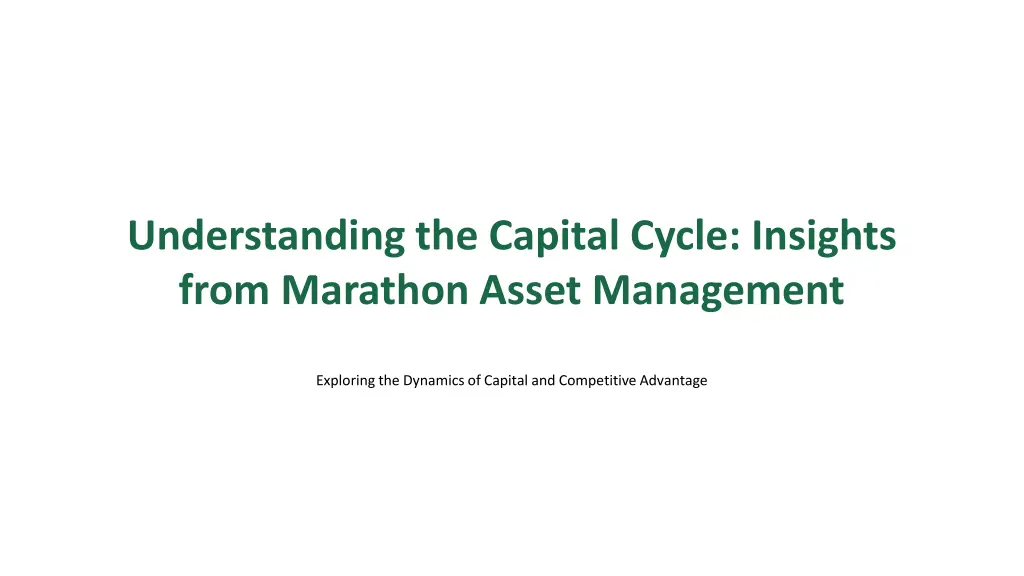
Insights into the Capital Cycle and Competitive Advantage
Discover the dynamics of the capital cycle and its impact on competitive advantage in businesses. Learn how capital flows influence strategic decisions, profitability, and industry positioning over time. Explore case studies, investment strategies, and the power of capital cycle analysis for informed decision-making.
Download Presentation

Please find below an Image/Link to download the presentation.
The content on the website is provided AS IS for your information and personal use only. It may not be sold, licensed, or shared on other websites without obtaining consent from the author. If you encounter any issues during the download, it is possible that the publisher has removed the file from their server.
You are allowed to download the files provided on this website for personal or commercial use, subject to the condition that they are used lawfully. All files are the property of their respective owners.
The content on the website is provided AS IS for your information and personal use only. It may not be sold, licensed, or shared on other websites without obtaining consent from the author.
E N D
Presentation Transcript
Understanding the Capital Cycle: Insights from Marathon Asset Management Exploring the Dynamics of Capital and Competitive Advantage
01 The Capital Cycle Concept Table of Contents 02 Analyzing Competitive Advantage 03 The Flow of Capital: A Case Study 04 Implications for Investment Strategies 05 Conclusion: The Power of Capital Cycle Analysis 06 Thank You!
1 The Capital Cycle Concept The capital cycle represents the ebb and flow of investment in businesses. It's a dynamic process where capital moves towards high-returnopportunities and exits when returns decline. Understanding this cycle is crucial for investors, as it influences the competitive positioning of companies within their industries over time. Capital inflow fosters growth and new investments, while outflow leads to capacity reduction, ultimately affecting profitability in cyclical patterns. This concept aligns with Schumpeter s notion of 'creative destruction', highlighting how economic busts rectify capital misallocation from previous booms. Recognizing these phases equips businesses with strategies to navigate their environmenteffectively.
2 Analyzing Competitive Advantage Capital cycle analysis is about understanding how changes in capital affect a firm's competitive edge in its sector. According to Michael Porter, competitive strategy hinges on relating a company to its environment, emphasizing the importance of market dynamics. Companies must assess the five forces that shape their industry: supplier power, buyer power, substitution threats, rivalry, and new entrants. As capital flows change, so does the competitive landscape, influencing strategic decisions and long-term sustainability. Investors must pay attention to how these factors evolve to predict future performance.
3 The Flow of Capital: A Case Study Consider Macro Industries, a thriving widget manufacturer exceeding its cost of capital. This success attracts more capital into its operations. Recognition leads to increased stock value and investor interest; in turn, this can prompt expansion and innovation. However, sustained high returns eventually attract competition, increasing industry capacity and consequently lowering returns. Understanding this sequence allows stakeholders to anticipate shifts in market conditions and strategize accordingly. Investing wisely means recognizing when to enter and exit based on the capital cycle principles.
4 Implications for Investment Strategies Investors should adopt a proactive approach, monitoring capital trends and competitive dynamics within industries. Diversifying across sectors can mitigate risks associated with cyclical downturns and capitalize on emerging opportunities. Identifying sectors in their growth phase can yield substantial returns before the competition escalates. Long-term perspectives are essential; patience can lead to significant profits as industries recover from downturns. Understanding the capital cycle informs more informed and strategic investment decisions.
5 Conclusion: The Power of Capital Cycle Analysis Marathon Asset Management's analytical framework provides insights into the cyclical nature of capital and its effect on profitability. By understanding the capital cycle, investors gain a competitive edge, adapting strategies to market fluctuations. The relationshipbetween capital flow and competitive advantage is crucial for sustainable growth. Future-orientedstrategies informed by capital cycle analysis can lead to more resilient investments. Grasping this concept is essential for anyone involved in investment or business strategy.
6 Thank You! Thank you for exploring the insights on the capital cycle and its implications for investment strategies. We hope this presentation has inspireda deeper understanding of market dynamics. Let s leverage these insights to make more informed decisions in our respective fields. Remember, every cycle presents an opportunity; let s navigate them wisely! Feel free to ask any questions or share your thoughts!
